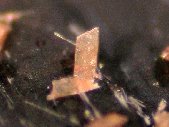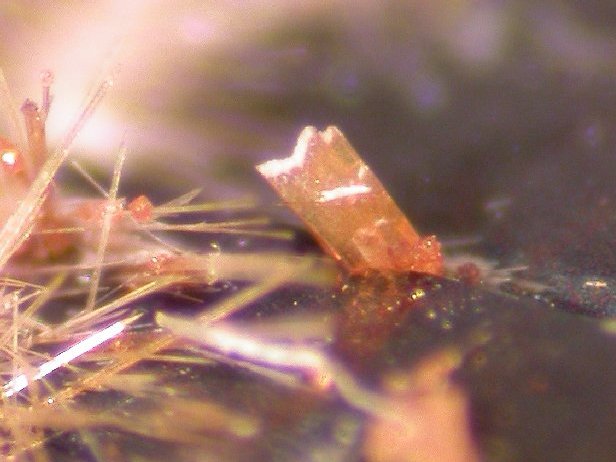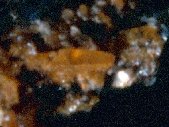Thumbnails

Perraultite crystals – 0,3mm
© Gilles Haineault

Perraultite crystals – 0,4mm
© Gilles Haineault

Perraultite crystals
© Reproduced courtesy of Canadian
Museum of Nature
Ottawa, Canada
[NaKBaMn(Ti,Nb)Si32(OH) · 2HO]
Perraultite (formerly UK17) was discovered in pegmatite dikes in the nepheline syenite. The luster appears vitreous on fresh faces and slightly waxy on exposed faces. Crystals of perraultite appear flattened on {010} and elongated along {100}. “Swallow-tail” type, simple, contact twins are common, with {001} as twin plane and composition plane.
PHYSICAL CHARACTERISTICS:
Color is orange brown.
Luster is vitreous to slightly waxy.
Diaphaneity is opaque to translucent, transparent in small fragments.
Crystal System is monoclinic; 2/, Cm or 2.
Crystal Habits include small prismatic crystals to 0.5mm.
Cleavage: {001} is very good.
Fracture is uneven to irregular.
Hardness is ~4.
Specific Gravity is approximately 3.71 g/cm
Streak is pale brown.
Associated Minerals include aegirine, albite, ancylite, calcite,
catapleiite, fluorite, kupletskite, lorenzenite, microcline, natrolite,
polylithionite, pyrochlore and rhodochrosite.
Distinguishing Features: Very Brittle. Non Fluorescent.
Origin: Named in honor of Emeritus Professor Guy Perrault (b. 1927),
of Ecole Polytechnique de Montréal in recognition of his contributions
to the study of mineralogy of the nepheline syenite at Mont Saint-Hilaire.
CLASSIFICATION:
Dana System
# 78.1.5.2
Strunz Classification
# VIII/D.03-20
REFERENCES:
MinRec 21:329 (1990), CanMin 29:355-358 (1991), Dana 8:1704 (1997)
DISTRIBUTION AND RARITY AT MONT SAINT-HILAIRE:
MSH
¤¤¤
